Fourth year thesis on perovskite materials published in the leading journal, AIP Advances
[sharexy]
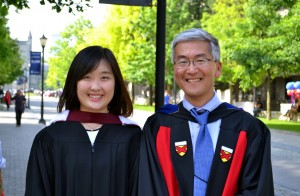
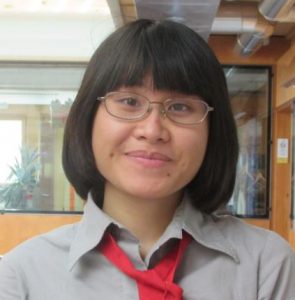
Recent graduate Rebecca Liu (MSE 1T4+PEY) with department chair Professor Jun Nogami at Spring Convocation 2015 (left) and Catherine Tran (MSE 1T4+PEY; right) published their fourth year thesis on perovskite materials in AIP Advances (photo: University of Toronto / Catherine Tran)
September 15, 2015 | By Luke Ng
Publishing a paper in a leading scientific journal can be described as one of the most rewarding moments in a researcher’s career—especially at the undergraduate level.
Recent graduates Rebecca Liu and Catherine Tran’s fourth year thesis was recently published in AIP Advances, a prestigious journal issued by the American Institute of Physics. Their paper, titled Stability of organometal perovskites with organic overlayers highlights their research advances on a hybrid material that can be used to enhance solar energy applications.
“The ability to effectively create modern organic semiconductor materials is essential to reducing the cost of solar energy, bringing it closer to mainstream use.”
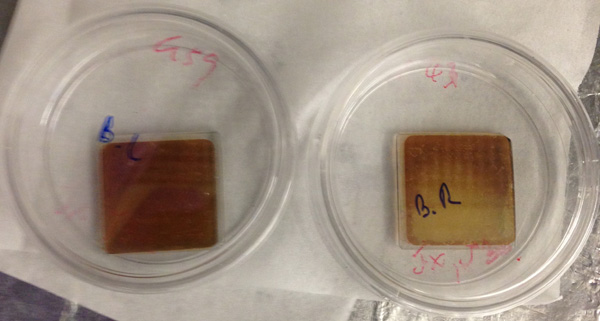
Degradation is significantly impeded by coating an ultra-thin over layer of transparent organic material on the perovskite thin film (left) compared to the bare exposed film (right); photo: Organic Optoelectronics Research Group, University of Toronto
“Traditional semiconductors, such as solar-grade silicon, possess the advantage of long-term stability but are expensive to manufacture,” said Professor Zheng-Hong Lu, Liu and Tran’s supervisor and Canada Research Chair in Organic Optoelectronics. “The ability to effectively create modern organic semiconductor materials is essential to reducing the cost of solar energy, bringing it closer to mainstream use.”
Liu and Tran’s research focused on stabilizing perovskite, a promising hybrid organic semiconductor material that can be used to augment expensive solar-grade silicon. However, its energy conversion ability drops significantly when exposed to air.
Liu and Tran were able to increase the perovskite material’s lifetime by 100-fold
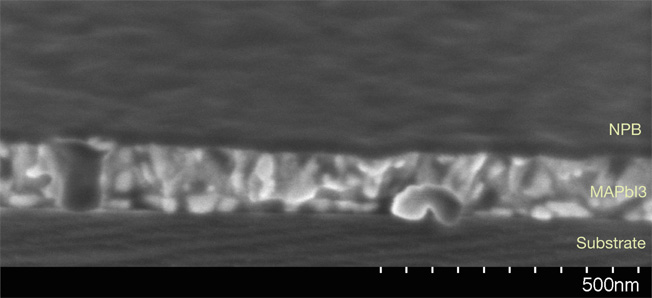
Cross-sectional scanning electron micrograph of a perovskite thin film and organic over layer (NPB), magnified 100,000 times and tilted at 70 degrees—the ultra-thin organic over layer protects the perovskite crystal grains from decomposition in ambient atmosphere (photo: Organic Optoelectronics Research Group, University of Toronto)
With the guidance of MASc candidate Emmanuel Thibau, the two undergraduate researchers investigated the use of a novel organic material to coat perovskite. Using x-ray diffraction and mathematical modelling techniques, Liu and Tran were able to overlay organic coatings ranging from 10 to 30-nm thick onto perovskite—dramatically increasing its lifetime by 100-fold.
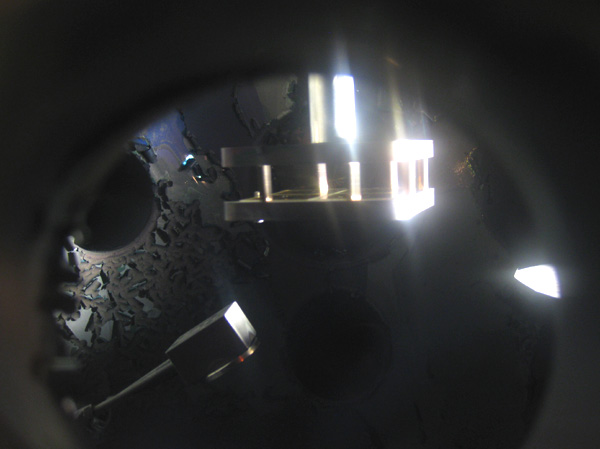
Evaporation tool inside vacuum chamber used to prepare the perovskite samples (photo: Catherine Tran)
“Having the chance to perform research during my undergraduate studies was one of the reasons I chose to attend U of T,” said Liu. “And on top of that, having the guidance and support to publish it has made my experience that much more meaningful.”
“It was really exciting to have the opportunity to work on a significant solar-energy project for my final year thesis,” said Tran. “I want to thank my research partner Rebecca for her many hours of work with me in and out of the lab, Emmanuel for his guidance and especially to Professor Lu for the chance to publish it.”
“This kind of work is a perfect example of how important materials science and engineering is in our global sustainability efforts,” said Professor Jun Nogami, chair of the U of T Department of Materials Science & Engineering. “Congratulations to Catherine and Rebecca on their distinguished accomplishment at such an early stage of their career and to the mentors who have consistently dedicated themselves to help our students succeed.”